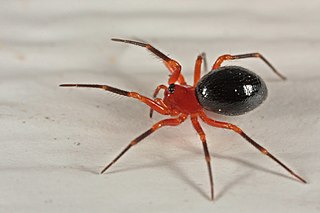
Agelenopsis, commonly known as the American grass spiders, is a genus of funnel weavers first described by C.G. Giebel in 1869. They weave sheet webs that have a funnel shelter on one edge. The web is not sticky, but these spiders make up for that shortcoming by running very rapidly. The larger specimens can grow to about 19 mm in body length. They may be recognized by the arrangement of their eight eyes into three rows. The top row has two eyes, the middle row has four eyes, and the bottom row has two eyes. They have two prominent hind spinnerets, somewhat indistinct bands on their legs, and two dark bands running down either side of the cephalothorax.

The Agelenidae are a large family of spiders in the suborder Araneomorphae. Well-known examples include the common "grass spiders" of the genus Agelenopsis. Nearly all Agelenidae are harmless to humans, but the bite of the hobo spider may be medically significant, and some evidence suggests it might cause necrotic lesions. However, the matter remains subject to debate. The most widely accepted common name for members of the family is funnel weaver.

Cybaeidae is a family of spiders first described by Nathan Banks in 1892. The diving bell spider or water spider Argyroneta aquatica was previously included in this family, but is now in the family Dictynidae.

Araniella is a genus of orb-weaver spiders first described by R. V. Chamberlin & Wilton Ivie in 1942.

Kukulcania is a genus of crevice weavers that was first described by Pekka T. Lehtinen in 1967. It is named after Kukulkan, a Mesoamerican serpent deity.
Saltonia is a monotypic genus of North American cribellate araneomorph spiders in the family Dictynidae containing the single species, Saltonia incerta. It was first described by R. V. Chamberlin & Wilton Ivie in 1942, and has only been found in United States. Originally placed with the funnel weavers, it was moved to the Dictynidae in 1967.

Metepeira is a genus of orb-weaver spiders first described by F. O. Pickard-Cambridge in 1903. The name is derived from the Ancient Greek μετά and the obsolete genus name Epeira, denoting a genus similar to Epeira.

Hololena is a genus of North American funnel weavers first described by R. V. Chamberlin & Willis J. Gertsch in 1929.
Rualena is a genus of North American funnel weavers first described by R. V. Chamberlin & Wilton Ivie in 1942.

Cybaeina is a genus of North American araneomorph spiders in the family Cybaeidae, and was first described by R. V. Chamberlin & Wilton Ivie in 1932. Originally described from a single female found in Olympia, Washington, it was placed with the Cybaeidae in 1967.
Yorima is a genus of araneomorph spiders in the family Cybaeidae, and was first described by R. V. Chamberlin & Wilton Ivie in 1942. Originally placed in the funnel weaver family, it was moved to the Dictynidae in 1967, and to the Cybaeidae in 2017.

Calymmaria is a genus of North American araneomorph spiders in the family Cybaeidae, and was first described by R. V. Chamberlin & Wilton Ivie in 1937. They have body lengths ranging from 2 to 10 millimetres.
Dirksia is a genus of araneomorph spiders in the family Cybaeidae, and was first described by R. V. Chamberlin & Wilton Ivie in 1942 as a subgenus of Ethobuella. Originally placed with the funnel weavers, it was elevated to genus and moved to the dwarf sheet spiders in 1967, then moved to the Cybaeidae in 2017. As of May 2019 it contains only two species: D. cinctipes and D. pyrenaea.
Varacosa is a genus of spiders in the family Lycosidae. It was first described in 1942 by Chamberlin & Ivie. As of 2017, it contains 6 North American species.
Arcuphantes is a genus of dwarf spiders that was first described by Ralph Vary Chamberlin & Vaine Wilton Ivie in 1943.
Linyphantes is a genus of North American dwarf spiders that was first described by Ralph Vary Chamberlin & Vaine Wilton Ivie in 1942.

Hammock spiders (Pityohyphantes) is a genus of sheet weavers that was first described by Eugène Louis Simon in 1929. The name comes from the Ancient Greek Πίτυς (pitys), meaning "pine", and hyphantes, meaning "weaver".
Pityohyphantes costatus, the hammock spider, is a species of sheetweb spider in the family Linyphiidae. It is found in the United States.

Hypselistes florens is a species of dwarf spider in the family Linyphiidae. It is found in the United States and Canada.










